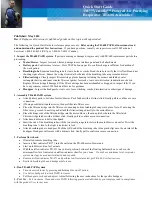
Safety
dryCAT-Series | Version 1.02
5
Only persons reliable working procedures can be ex-
pected from, are allowed to perform all works. Persons
the responsiveness of which is affected by e. g. drugs,
alcohol or medication, are not allowed to work with the
machine. The qualifications of the personnel for the diffe-
rent tasks are mentioned below:
Operator:
The operator is instructed by the operating company
about the assigned tasks and possible risks in case of
improper behaviour. Any tasks which need to be per-for-
med beyond the operation in the standard mode must
only be performed by the operator if it is indicated in
these instructions and if the operating company ex-pres-
sively commissioned the operator.
Electrically qualified person:
Electrically qualified person is due to their professional
training, knowledge and experience as well as knowl-
edge of the relevant standards and regulations, in a po-
sition to carry out work on the electrical systems and to
independently recognize and avoid possible dangers.
Qualified personnel:
Due to their professional training, knowledge and expe-
rience as well as their knowledge of relevant regulations
the specialist staff is able to perform the assigned tasks
and to recognise and avoid any possible dangers them-
selves.
Manufacturer:
Certain works may only be performed by specialist per-
sonnel of the manufacturer. Other personnel is not au-
thorized to perform these works. Please contact our cus-
tomer service for the execution of all arising work.
2.4 Personal protective equipment
The personal protective equipment serves to protect per-
sons against impairments of safety and health while wor-
king. The staff member has to wear personal protec-tive
equipment while performing different tasks on and with
the machine which are indicated in the individual para-
graphs of these instructions.
The personal protective equipment is explained in the
following paragraph:
2.5 General safety regulations
Please note the following:
- Use the protective devices and fasten them se-
curely. Never work without the guards and keep
them in working order.
- Do not change the design of the dry vacuum cleaner
and do not use it for purposes other than the opera-
tions foreseen by the manufacturer.
- Ensure that there is sufficient lighting.
- Never work under the influence of diseases that im-
pair concentration, overtiredness, drugs, alcohol or
medication.
- Keep children and persons not familiar with the dry
vacuum cleaner away from their working environ-
ment.
- The dry vacuum cleaner must not be used by per-
sons with reduced physical, sensory or mental ca-
pacity.
- Do not pull on the power cord to unplug it from the
wall outlet. Protect the cord from heat, oil and sharp
edges.
- Immediately eliminate malfunctions that affect
safety.
- Protect the dry vacuum cleaner from moisture (risk
of short circuit).
- Before each use, make sure that no parts are dam-
aged on the dry vacuum cleaner.
- Damaged parts must be replaced immediately to
avoid sources of danger.
- Do not overload the dry vacuum cleaner! It works
better and safer in the specified power range.
- The unit must be used, assembled, repaired and
transported on a stable and safe surface.
- Do not use this unit outdoors, in high humidity envi-
ronments, or at low temperatures.
- Do not vacuum dust without a filter.
- Do not vacuum flammable materials.
- Do not vacuum explosive materials.
- Do not use the unit to vacuum explosive or flamma-
ble gases, liquids and dust particles, undiluted,
strong acids and alkalis, metal dust particles (such
as aluminum, magnesium, zinc) in combination with
strong alkaline or acid cleaning agents .
- Do not vacuum substances that can cause explo-
sions when in contact with air.
- Do not exceed the max. filling level of the container
- Do not use the vacuum cleaner in areas with tem-
peratures above 40 ° C.
- Do not vacuum glowing objects.
- Never open the tank during operation.
Protective gloves
The protective gloves serve to protect the hands
against sharp components as well as against fric-
tion, abrasions or deep injuries.
Safety boots
Safety boots protect the feet from being crushed, fal-
ling parts and slipping over on slippery ground.
Protective clothes
Protective clothes are made of a tightly fitted fabric
without the protruding parts of low tear strength.




































